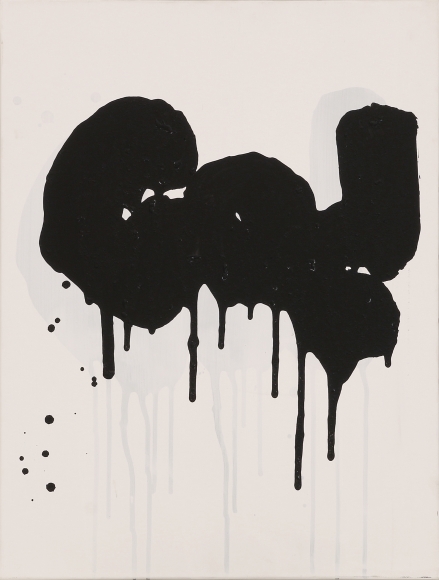
Yang Jiechang, Śarīra No. 2 (Relics No. 2), 2014; Ink on Xuan paper, mounted on canvas, 64 x 148 cm
Born in Foshan, Guangdong Province, China in 1956, Yang studied paper mounting, folk art, and traditional Chinese painting at the Foshan Folk Art Research Institute (1974 –1978) and Chinese painting at the Guangzhou Academy of Fine Arts, Guangzhou (1978 –1982). In the early 1980s he also studied Dao at the Daoist temple Chongxu on Mount Luofu, a major influence on his way of life and artistic practice.
Invited to participate in the influential exhibition Les Magiciens de la Terre at the Centre Pompidou, Paris in 1989, Yang was represented by four large works in which the calligraphic impulse was replaced by concentration on the basic elements of ink painting – ink, water and paper. Known as Hundred Layers of Ink, this series of works was to be his major pre-occupation throughout the 1990s. Since 1989 Yang has been based in Paris and Heidelberg.
Yang has described his first decade in Europe as one of introspection and reinvention. “Reviewing these works now,” he has commented,” I realize that I was immersed in silence in anticipating the arrival of another era.” This exhibition focuses on works in ink executed between 1999 and 2017 that reveal much greater stylistic diversity. Although he has added video, installation, and performance to his repertoire, ink painting remains his core practice, and it is his unmistakable brushwork that underpins these various works. Jiechang now feels free to utilize whichever of the three major disciplines of traditional Chinese painting – calligraphy, ink painting, and meticulous color painting (gongbi) – is most appropriate for his immediate needs, and all three are represented among the works shown here.

Yang Jiechang, Difficult, 2008; Ink on Xuan paper, mounted on canvas, 105 x 105 cm
As an art form, calligraphy is inseparable from the Chinese language but resident in Europe since 1989, Yang speaks not only Cantonese and Mandarin, but also English, German and French in a highly idiosyncratic manner. His calligraphy is equally unorthodox, obeying none of the rules nor conforming to any of the major styles. “When I am doing calligraphy today,” he has said, “I too rarely do it according to the rules. There is not one brushstroke that is not mistake, all are wrong, not one is good, which makes them all harmonizing in the end.” In the current exhibition the words Difficult (2008) and God (2014) are unlikely candidates for the expressive calligraphic transformation they undergo. Heaven and Earth in One Stroke #2 and #4 (2017) are celebrations of dynamic brushwork for its own sake, while The Steps of the Great Yu (1999) refers to a dance step of religious Daoism.

Yang Jiechang, God, 2014; Ink on Xuan paper, mounted on canvas, 64 x 48 cm
In complete contrast to the calligraphic works is Golden Mountain (2012-2017) a three-panel landscape which is executed in the meticulous style known as gongbi. Labor-intensive as it is, Yang has turned to this technique repeatedly and generally for very large works as in Crying Landscape (2002) a set of five triptychs first exhibited at the Venice Biennale in 2003. Golden Mountain is associated with a group of works that began with Tale of the 11th Day – Golden Day(2011-2012), eight panels representing animals of different species and human beings in a golden landscape. First conceived during the world financial crisis of 2007-2008, Yang’s ambitious sequence of paintings creates an alternative world in which harmony between different species offers an unsettling perspective on current economic and social trends.
Among contemporary Chinese artists Yang Jiechang has established himself as a uniquely provocative figure, an expatriate for nearly thirty years yet still deeply immersed in Chinese cultural and artistic traditions. Fully aware of the distinctiveness of his position, he has commented that “I keep a certain distance from the convention of figurative painting proper to socialist realism and globalized capitalism, but I also avoid rushing headlong into the ancient conventions of abstract and conceptual calligraphy. That is why I think my art is very particular, very disturbing both in China and the West.”
About the exhibition
Dates: September 7 – October 17, 2017
Venue: Chambers Fine Art
Courtesy of the artist and Chambers Fine Art, for further information please visit www.chambersfineart.com.




























